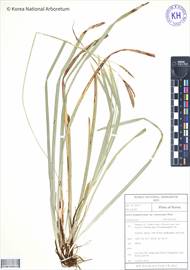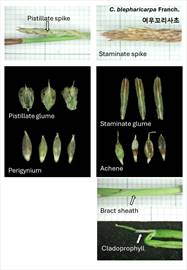Scientific Name
Carex blepharicarpa var. stenocarpa Ohwi 여우꼬리사초
Subgenus classification
: Carex.
Habitats
Occurs in Gyeongbuk.
Stem
Clumped growth, with basal sheath color dark brown to reddish brown, and length about 20-50 cm.
Leaves
Leaves longer than the stem, similar to the stem or shorter than the stem, have glabrous surfaces, width about 2-6 mm.
Inflorescence
The number of spikes two or more. Spike shapes different (showing distinct sexual characteristics), with all spikes unisexual, spikes arranged loosely. Terminal spike sexuality staminate. Lateral spike sexuality pistillate, and erect to ascend. Lateral spike length about 1-3 cm. Terminal spike length about 1-3 cm. Number of spikes per node one (one spike in one bract).
Bract
Lowermost bract shape thread-like or scale-like.
Glume
Staminate glume awn short (awn less than one-third of the total length). Pistillate glume awn short (awn less than one-third of the total length). Pistillate glume color whitish green to light brown.
Perigynium
Transverse section trigonous to terete. Perigynium shape obovate (the broadest part near the apex) or elliptical to narrow elliptical (the broadest part in the center), and densely flowered or loosely flowered. Perigynium hairy or pubescent. Beak short (beak less than one-third of the total length) or long (beak more than one-third of the total length), thick (the beak is not distinguished from the perigynium , and the starting point of the beak is more than one-third of the widest part of the perigynium), with truncate or bidentate to bifid mouth. Length 4-6 mm.
Achene
Appendage absent, no constrictions.
Copyright © 2024. All rights reserved.


